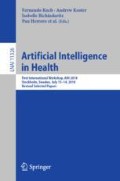Abstract
In the fight against cancer, cancer registries are an important tool. At the heart of these registries is the data collection and coding process. This process is ruled by complex international standards and numerous best practices, which can easily overwhelm (coding) operators. In this paper, a system assisting operators in the interpretation of best medical coding practices and a short evaluation are presented. By leveraging the arguments used by the coding experts to determine the best coding option, the proposed system answers coding questions from operators and provides a partial explanation for the proposed solution.
Access this chapter
Tax calculation will be finalised at checkout
Purchases are for personal use only
Notes
- 1.
An adenopathy is an enlargement of lymph nodes, likely due to cancer.
- 2.
The morphology describes the type and behavior of the cells that compose the tumor.
- 3.
The topography is the location where the tumor originated.
- 4.
- 5.
- 6.
- 7.
- 8.
References
Aamodt, A., Plaza, E.: Case-based reasoning: foundational issues, methodological variations, and system approaches. AI Commun. 7, 39–59 (1994)
Bichindaritz, I., Marling, C., Montani, S.: Case-based reasoning in the health sciences. In: Workshop Proceedings of ICCBR (2015)
Brickley, D., Guha, R.V.: RDF Schema 1.1, W3C recommendation, last consultation: March 2017 (2014). https://www.w3.org/TR/rdf-schema/
Bunke, H., Messmer, B.T.: Similarity measures for structured representations. In: Wess, S., Althoff, K.-D., Richter, M.M. (eds.) EWCBR 1993. LNCS, vol. 837, pp. 106–118. Springer, Heidelberg (1994). https://doi.org/10.1007/3-540-58330-0_80
Tyczynski, J.E., Démaret, E., Parkin, D.M., European Network of Cancer Registries: Standards and Guidelines for Cancer Registration in Europe: the ENCR Recommendations. International Agency for Research on Cancer, Lyon (2003)
Maximini, K., Maximini, R., Bergmann, R.: An investigation of generalized cases. In: Ashley, K.D., Bridge, D.G. (eds.) ICCBR 2003. LNCS (LNAI), vol. 2689, pp. 261–275. Springer, Heidelberg (2003). https://doi.org/10.1007/3-540-45006-8_22
McSherry, D.: Explaining the pros and cons of conclusions in CBR. In: Funk, P., González Calero, P.A. (eds.) ECCBR 2004. LNCS (LNAI), vol. 3155, pp. 317–330. Springer, Heidelberg (2004). https://doi.org/10.1007/978-3-540-28631-8_24
Richter, M.M., Weber, R.O.: Case-Based Reasoning: A Textbook. Springer, Berlin (2013). https://doi.org/10.1007/978-3-642-40167-1
Schnell, M., Couffignal, S., Lieber, J., Saleh, S., Jay, N.: Case-based interpretation of best medical coding practices—application to data collection for cancer registries. In: Aha, D.W., Lieber, J. (eds.) ICCBR 2017. LNCS (LNAI), vol. 10339, pp. 345–359. Springer, Cham (2017). https://doi.org/10.1007/978-3-319-61030-6_24
Acknowledgments
The authors wish to thank the anonymous reviewers of the Joint Workshop on Artificial Intelligence in Health for their remarks which have helped in improving the quality of the paper. The first author would also like to thank the Fondation Cancer for their financial support.
Author information
Authors and Affiliations
Corresponding author
Editor information
Editors and Affiliations
Rights and permissions
Copyright information
© 2019 Springer Nature Switzerland AG
About this paper
Cite this paper
Schnell, M., Couffignal, S., Lieber, J., Saleh, S., Jay, N. (2019). Interpretation of Best Medical Coding Practices by Case-Based Reasoning—A User Assistance Prototype for Data Collection for Cancer Registries. In: Koch, F., et al. Artificial Intelligence in Health. AIH 2018. Lecture Notes in Computer Science(), vol 11326. Springer, Cham. https://doi.org/10.1007/978-3-030-12738-1_14
Download citation
DOI: https://doi.org/10.1007/978-3-030-12738-1_14
Published:
Publisher Name: Springer, Cham
Print ISBN: 978-3-030-12737-4
Online ISBN: 978-3-030-12738-1
eBook Packages: Computer ScienceComputer Science (R0)

